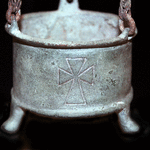Byzantine Bronze Hanging Incence Burner, 400 CE - 600 CE
Bronze
MT.0290
Further images
A cross of light bearing the inscription “in hoc signo vinces” (in this sign you will conquer) miraculously appeared to Roman Emperor Constantine before the battle of Milvian Bridge. His...
A cross of light bearing the inscription “in hoc signo vinces” (in this sign you will conquer) miraculously appeared to Roman Emperor Constantine before the battle of Milvian Bridge. His victory over his brother-in-law and co-emperor Maxentius and subsequent conversion to Christianity had a profound impact on the course of Western civilization.
Byzantine is the term commonly used since the 19th century to refer to the Greek-speaking Roman Empire of the Middle Ages centered in the capital city of Constantinople. During much of its history, it was known to many of its Western contemporaries as the Empire of the Greeks, due to the dominance of the Greek language and culture. However, it is important to remember that the Byzantines referred to themselves as simply as the Roman Empire. As the Byzantine era is a period largely fabricated by historians, there is no clear consensus on exactly when the Byzantine age begins; although many consider the reign of Emperor Constantine the Great, who moved the imperial capital to the glorious city of Byzantium, renamed Constantinople and nicknamed the “New Rome,” to be the beginning. Others consider the reign of Theodosius I (379-395), when Christianity officially supplanted the pagan beliefs, to be the true beginning. And yet other scholars date the start of the Byzantine age to the era when division between the east and western halves of the empire became permanent.
While Christianity replaced the gods of antiquity, traditional Classical culture continued to flourish. Greek and Latin were the languages of the learned classes. Before Persian and Arab invasions devastated much of their eastern holdings, Byzantine territory extended as far as south as Egypt. After a period of iconoclastic uprising came to resolution in the 9th Century, a second flowering of Byzantine culture arose and lasted until Constantinople was temporarily seized by Crusaders from the west in the 13th Century. Christianity spread throughout the Slavic lands to the north. In 1453, Constantinople finally fell to the Ottoman Turks effectively ending the Byzantine Empire after more than 1,100 years. Regardless of when it began, the Byzantine Empire continued to carry the mantle of Greek and Roman Classical cultures throughout the Medieval era and into the early Renaissance, creating a golden age of Christian culture that today continues to endure in the rights and rituals of the Eastern Orthodox Church. Byzantine art and culture was the epitome of luxury, incorporating the finest elements from the artistic traditions of both the East and the West.
This bronze vessel was used for burning incense and would have been carried and swung by its chain or suspended from a wall or ceiling. Incense was introduced into the Christian liturgy after the reign of Constantine the Great. Open censers such as this one represent an early form and appear in Early Byzantine mosaics, for example those of S.Vitale in Ravenna. The censer is circular in form with a design of engraved crosses decorating the sides. The lip is wide and flat and the vessel rests on three slightly flared legs. Suspension loops connect the three chains to a tripartite fastening. Miniature cross pendants dangle at the joins. Although the use of censers was not confined to ecclesiastical settings, the presence of crosses suggests that this was its original function.
Byzantine is the term commonly used since the 19th century to refer to the Greek-speaking Roman Empire of the Middle Ages centered in the capital city of Constantinople. During much of its history, it was known to many of its Western contemporaries as the Empire of the Greeks, due to the dominance of the Greek language and culture. However, it is important to remember that the Byzantines referred to themselves as simply as the Roman Empire. As the Byzantine era is a period largely fabricated by historians, there is no clear consensus on exactly when the Byzantine age begins; although many consider the reign of Emperor Constantine the Great, who moved the imperial capital to the glorious city of Byzantium, renamed Constantinople and nicknamed the “New Rome,” to be the beginning. Others consider the reign of Theodosius I (379-395), when Christianity officially supplanted the pagan beliefs, to be the true beginning. And yet other scholars date the start of the Byzantine age to the era when division between the east and western halves of the empire became permanent.
While Christianity replaced the gods of antiquity, traditional Classical culture continued to flourish. Greek and Latin were the languages of the learned classes. Before Persian and Arab invasions devastated much of their eastern holdings, Byzantine territory extended as far as south as Egypt. After a period of iconoclastic uprising came to resolution in the 9th Century, a second flowering of Byzantine culture arose and lasted until Constantinople was temporarily seized by Crusaders from the west in the 13th Century. Christianity spread throughout the Slavic lands to the north. In 1453, Constantinople finally fell to the Ottoman Turks effectively ending the Byzantine Empire after more than 1,100 years. Regardless of when it began, the Byzantine Empire continued to carry the mantle of Greek and Roman Classical cultures throughout the Medieval era and into the early Renaissance, creating a golden age of Christian culture that today continues to endure in the rights and rituals of the Eastern Orthodox Church. Byzantine art and culture was the epitome of luxury, incorporating the finest elements from the artistic traditions of both the East and the West.
This bronze vessel was used for burning incense and would have been carried and swung by its chain or suspended from a wall or ceiling. Incense was introduced into the Christian liturgy after the reign of Constantine the Great. Open censers such as this one represent an early form and appear in Early Byzantine mosaics, for example those of S.Vitale in Ravenna. The censer is circular in form with a design of engraved crosses decorating the sides. The lip is wide and flat and the vessel rests on three slightly flared legs. Suspension loops connect the three chains to a tripartite fastening. Miniature cross pendants dangle at the joins. Although the use of censers was not confined to ecclesiastical settings, the presence of crosses suggests that this was its original function.





